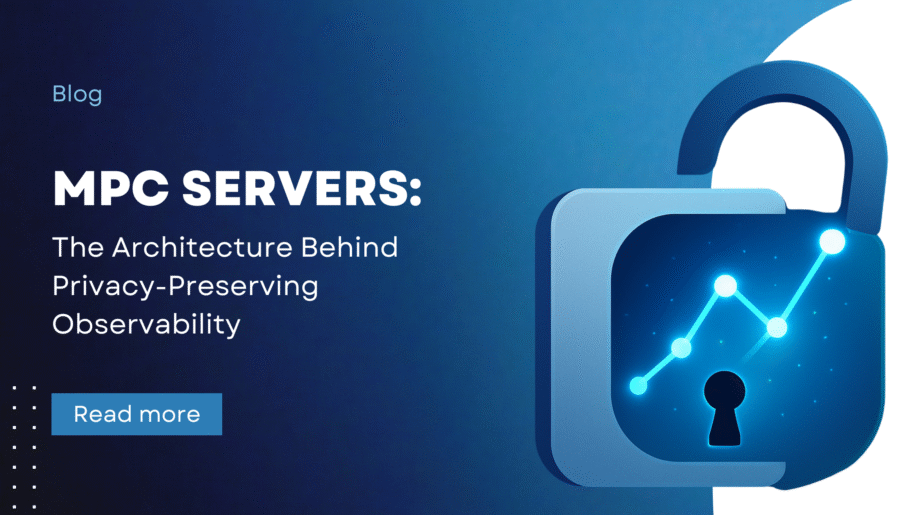Multi-Party Computation (MPC) servers are emerging as critical infrastructure for organizations that require collaborative analytics without compromising data privacy. In the observability space, these specialized servers enable a new paradigm: gaining collective insights from distributed systems while maintaining complete data sovereignty. This in-depth exploration examines the architecture, protocols, and operational considerations of MPC servers in contemporary observability platforms.
Understanding MPC Server Architecture
At its core, an MPC server is a specialized compute node designed to perform cryptographic operations on secret-shared data. Unlike traditional servers that process plaintext data, MPC servers work with mathematical shares that reveal no information about the underlying data.
Core Components of an MPC Server
- Secret Sharing Engine
- Splits input data into cryptographic shares using protocols like Shamir’s Secret Sharing or additive secret sharing.
- Manages share distribution across the MPC cluster
- Handles share reconstruction for authorized outputs
- Secure Computation Runtime
- Executes arithmetic and boolean circuits on secret-shared data
- Implements protocols like GMW, BGW, or SPDZ for different security models
- Optimizes computation paths for everyday observability operations (sum, average, min/max, percentiles)
- Network Communication Layer
- Manages authenticated channels between MPC nodes
- Implements optimized protocols for share exchange
- Handles Byzantine fault tolerance in adversarial settings
- State Management
- Maintains computation state across multi-round protocols
- Implements secure storage for intermediate values
- Manages protocol checkpoints for failure recovery
MPC Protocol Selection for Observability Workloads
Different MPC protocols offer varying trade-offs between security, performance, and functionality. For observability platforms, the choice of protocol significantly impacts system design:
Information-Theoretic Protocols (BGW, GMW)
Advantages:
- Perfect security against computationally unbounded adversaries
- No reliance on cryptographic assumptions
- Lower computational overhead per operation
Observability Use Cases:
- High-security environments (financial services, healthcare)
- Scenarios where long-term data confidentiality is critical
- Smaller-scale deployments with trusted infrastructure
Limitations:
- Requires honest majority of servers
- Higher communication complexity
- Not suitable for wide-area deployments
Computational Protocols (SPDZ, MASCOT)
Advantages:
- Security against a dishonest majority
- Better suited for adversarial environments
- Can operate with just two parties
Observability Use Cases:
- Cross-organization collaborations
- Public cloud deployments
- Scenarios with potential malicious actors
Trade-offs:
- Higher computational overhead
- Requires a preprocessing phase
- Dependent on cryptographic hardness assumptions
Hybrid Protocols
Modern MPC servers often implement hybrid approaches:
- Use information-theoretic sharing for data distribution
- Apply computational protocols for actual computation
- Optimize different phases for specific observability metrics
Optimizing MPC Servers for Observability Metrics
Observability workloads have unique characteristics that MPC servers must accommodate:
1. High-Volume Time Series Data
MPC servers handling metrics must process millions of data points efficiently:
Optimization Strategies:
- Batching: Aggregate multiple metrics into a single MPC operation
- Approximation: Use privacy-preserving sketches for approximate statistics
- Hierarchical Aggregation: Compute local aggregates before MPC operations
Implementation Example:
// Instead of computing individual metrics
for each metric in metrics_stream:
mpc_compute(metric) // Inefficient
// Batch processing approach
metric_batch = batch_metrics(metrics_stream, size=1000)
mpc_compute_batch(metric_batch) // Much more efficient
2. Real-Time Processing Requirements
Traditional MPC protocols struggle with real-time constraints. Modern MPC servers address this through:
Preprocessing Separation:
- Expensive cryptographic operations performed offline
- Online phase uses preprocessed materials for fast computation
- Continuous preprocessing maintains material pools
Circuit Optimization:
- Custom circuits for common observability operations
- SIMD (Single Instruction, Multiple Data) operations on secret shares
- Vectorized implementations of statistical functions
3. Dynamic Participant Sets
Observability platforms often have varying numbers of participants:
MPC Server Adaptations:
- Dynamic secret sharing schemes
- Proactive share refresh protocols
- Elastic scaling of MPC clusters
MPC Server Deployment Patterns
1. Dedicated MPC Cluster
Organizations deploy dedicated MPC server clusters for observability:
Architecture:
[Observability Agent] → [MPC Gateway] → [MPC Server Cluster]
├── MPC Node 1
├── MPC Node 2
└── MPC Node 3
Benefits:
- Optimized for specific workloads
- Better performance isolation
- Simplified security boundaries
2. MPC-as-a-Service
Cloud providers offer MPC servers as managed services:
Components:
- Multi-tenant MPC infrastructure
- API-based access to MPC operations
- Integrated with existing observability pipelines
Considerations:
- The trust model includes a service provider
- Potential for better economies of scale
- Simplified operational overhead
3. Federated MPC Networks
Multiple organizations contribute MPC servers to a shared network:
Topology:
Org A MPC Servers ←→ Org B MPC Servers
↑ ↑
↓ ↓
Org C MPC Servers ←→ Org D MPC Servers
Advantages:
- No single point of trust
- Geographic distribution for resilience
- Aligned incentives among participants
Performance Engineering for MPC Servers
Computation Optimization
- Circuit Depth Reduction
- Minimize multiplication depth in arithmetic circuits
- Use approximation algorithms where exact computation isn’t required
- Implement specialized circuits for common operations
- Parallelization Strategies
- Thread-level parallelism for independent computations
- GPU acceleration for suitable protocols
- Distributed computation across MPC nodes
- Memory Management
- Efficient share representation to minimize memory footprint
- Streaming algorithms for large datasets
- Garbage collection is aware of the cryptographic material lifecycle
Network Optimization
- Communication Patterns
- Minimize round complexity in protocols
- Batch communication to reduce latency impact
- Use network coding for efficient multicast
- Bandwidth Management
- Compress shares where possible
- Delta encoding for time series data
- Adaptive protocols based on network conditions
- Geographic Distribution
- Strategic MPC server placement to minimize latency
- Regional clusters for local computations
- Hierarchical aggregation to reduce wide-area traffic
Security Hardening for MPC Servers
1. Side-Channel Protection
MPC servers must defend against side-channel attacks:
- Constant-time implementations of cryptographic operations
- Memory access pattern obfuscation
- Power analysis countermeasures
2. Malicious Adversary Protection
- Implement verifiable secret sharing
- Use commitment schemes for input validation
- Deploy zero-knowledge proofs for computation correctness
3. Infrastructure Security
- Hardware security modules (HSMs) for key management
- Secure enclaves for critical operations
- Network isolation and encrypted communication channels
Operational Considerations
Monitoring MPC Servers
Ironically, monitoring MPC servers requires careful consideration:
- Performance metrics must not leak information about computations
- Health checks need to respect privacy boundaries
- Audit logs must balance transparency with confidentiality
Capacity Planning
MPC servers have unique capacity requirements:
- Preprocessing material generation creates a baseline load
- Computation costs scale non-linearly with participant count
- Network bandwidth often becomes a bottleneck before the CPU
Failure Handling
MPC protocols must gracefully handle server failures:
- Redundant share distribution
- Protocol checkpointing for recovery
- Automatic failover with share reconstruction
Future Directions for MPC Servers
Hardware Acceleration
- Custom ASICs for MPC operations
- FPGA implementations of standard protocols
- Trusted execution environments (TEEs) for hybrid approaches
Protocol Innovation
- Quantum-resistant MPC protocols
- Improved preprocessing techniques
- Function-specific optimizations for observability
Standardization
- Common APIs for MPC operations
- Interoperability between different MPC implementations
- Industry-standard benchmarks for MPC server performance
Implementing MPC Servers: A Practical Checklist
For organizations deploying MPC servers for observability:
- Protocol Selection
- Assess security model (semi-honest vs. malicious)
- Determine acceptable performance trade-offs
- Consider long-term cryptographic requirements
- Infrastructure Planning
- Calculate computational requirements based on metric volume
- Design network topology for optimal communication
- Plan for preprocessing material generation
- Integration Strategy
- Define interfaces with existing observability stack
- Implement data classification for MPC processing
- Design fallback mechanisms for MPC unavailability
- Operational Readiness
- Establish monitoring without compromising privacy
- Create runbooks for common failure scenarios
- Train operations team on MPC-specific considerations
MPC servers represent a fundamental shift in how we architect systems
In the observability domain, they enable unprecedented collaboration while maintaining strict data boundaries. As these systems mature, we’re seeing convergence around common patterns and best practices.
The key to successful Multi-Party Computation server deployment lies in understanding the unique constraints and opportunities they present. By carefully selecting protocols, optimizing for specific workloads, and building robust operational practices, organizations can harness the power of collaborative computation without compromising on privacy or security.
As we move toward an increasingly interconnected yet privacy-conscious world, MPC servers will likely become as fundamental to our infrastructure as load balancers and databases are today. The organizations that master this technology now will be best positioned to build the privacy-preserving observability platforms of tomorrow.












